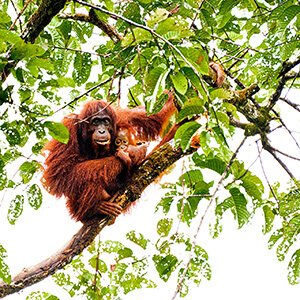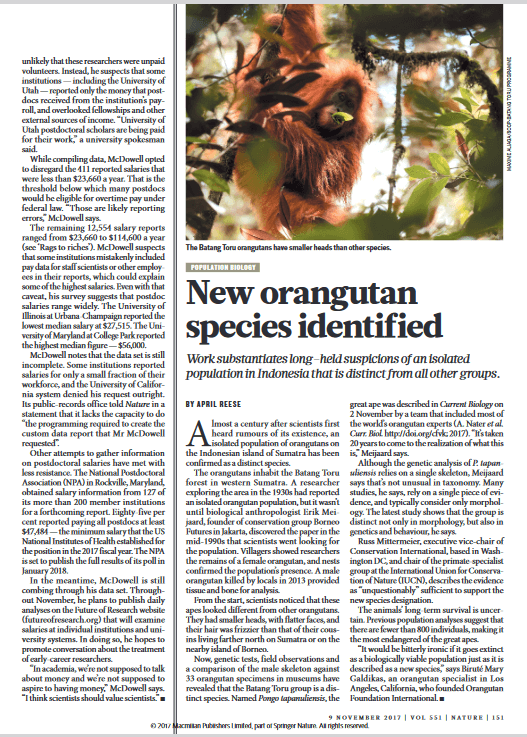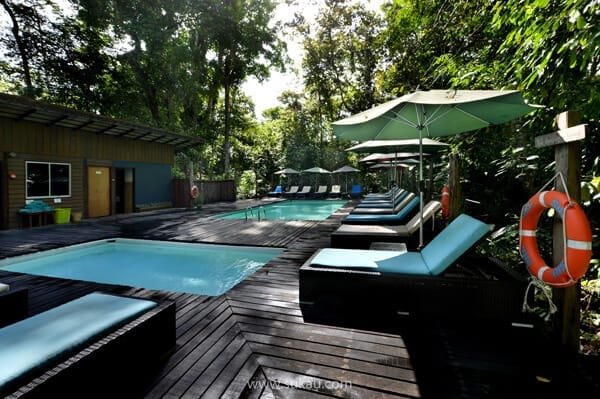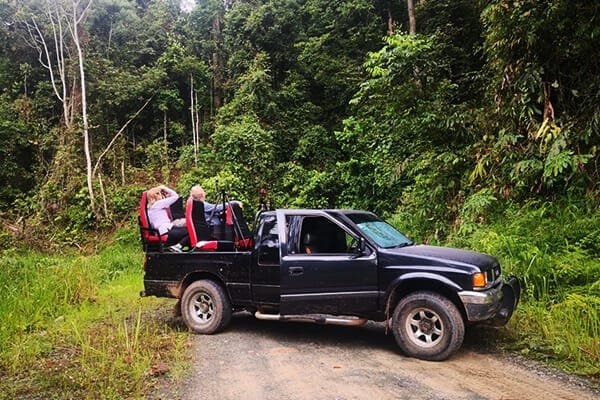Where to see Orangutan in the wild?
Below are the best places to see wild orangutan in Sabah, Malaysia
There are three species of orangutans (scientific details about orangutan speciation is at the end of this post) live today in Sumatra and Borneo, ranging in two countries, Malaysia and Indonesia.
In this blog post we only focus on locations in the Malaysian state of Sabah, where a considerable population of wild Orangutan thrives in the wild, and one gets a fair chance to spot them with the assistance of a trained guide:
Wild orangutans are seen in all four destinations regularly, and you will have chances to see one in these forests in the order mentioned.
Deramakot Forest Reserve has earned a reputation as one of Sabah’s greatest wildlife viewing locations. While Deramakot Forest Reserve is likely more known for its cats (including the rare clouded leopard), it is also a fantastic spot to watch wild orangutans in their natural habitat. Given that Deramakot is a logging concession, this may come as a surprise. The orangutans are frequently seen along the two main dirt lanes that run through the forest reserve. They are also occasionally sighted around the Park HQ. Unfortunately, Deramakot Forest Reserve lies off the beaten path for the independent tourists, the only way to visit this secluded reserve is with a tour operator, you can contact us for an all inclusive guided Deramakot Trip.
As a result, the majority of orangutan enthusiasts visit Kinabatangan River (the villages of Sukau, Bilit and Abai) for easy access. The best way to see orangutan are early morning and late evening boat tours, which may be scheduled as a day trip from Sandakan or as an overnight stay. There are lots of hotels, homestay options in Kinabatangan. And it sometimes get crazily crowded. We recommend to stay in the Kinabatangan Wetlands Resort for the finest wildlife viewing experience away from the crowd.
Danum Valley is a remote and untamed tropical rainforest with suspended canopy walkways and various trails. Danum Valley is undoubtedly the best place to encounter a wild orangutan on foot. Just imagine yourself in front of an alpha male orangutan in a virgin rainforest, no tourist to spoil the moment. Borneo Rainforest Lodge is undoubtedly the best option to stay while exploring Danum Valley.
Tabin Wildlife Reserve is a large protected area with a fair chance of spotting an orangutan, additionally Sepilok Rehab centre is releasing semi-wild orangutans in Tabin. But it is not as likely as in Deramakot or Kinabatangan or Danum
For a detailed comparison of these four best destinations of Borneo, refer to our blog post:


Photograph Wild Orangutan
We will take you to a remote forest where you can find actual Wild Orangutan, not relocated from rehab centers, also there is no feeding station here. So when you find one, the orangutan will be in its natural habitat displaying its Natural Behavior. Bear in mind that these animals are not comfortable with sudden human presence, unlike the ones you may observe in the rehab centers. So please stay quiet, no sudden move and give them some time to feel at ease with your presence.
The adult wild orangutans usually look opposite of us or just hide their face with their hands or leaves, and stay completely still so that we cannot find them. Once they feel no threats from us, they slowly will continue to display interesting behaviors. A baby orangutan on the other hand is very curious when it sees us, and its mother has a hard time keeping the baby from looking at us.
Most tourists, when visiting Sabah state of Borneo, stop by Sepilok Orangutan Rehabilitation Centre, where Orangutans are treated and rehabilitated at these centers before being released into semi-wild circumstances in private forest reserves. Sightings are nearly certain, as there are daily feeding hours when the animals have the opportunity to clamber down from the canopy to eat fruit.
Why therefore go through the difficulty of trying to see orangutans in the wild, where sightings are not assured and the orangutans may be high in the forest canopy, when it is so much easier to see them at a rehab?
Put it this way, it’s like contrasting a zoo with a safari. The excitement of finally catching a glimpse of one of these orange-furred monsters, no matter how high in the treetops, is amplified by the rarity of such encounters. There is complete stillness, and it is enchanting to simply be present. In addition, you won’t encounter the hordes of tourists who show up for the daily feedings at the rehabilitation centers, even at the more well-known protected locations like Kinabatangan. And in some of the more remote forest areas, you’re unlikely to run into any other tour groups.
The best wildlife encounters don’t just involve seeing an animal; rather, they involve being totally immersed in its ecosystem, experiencing natural behaviors, looking out for clues (such as prints or discarded fruit), and being fully conscious that you are in their area, not vice versa.
Furthermore, while the sanctuaries are doing an excellent job of helping orphaned, injured, or displaced orangutans, visiting national parks and wildlife reserves puts much needed funding into preserving these wild areas, which reduces illegal logging and hunting and means less chance of the forest being sold off for logging or industrial agriculture. There would be no need for the sanctuaries if the rainforests of Borneo and Sumatra were allowed to remain unaltered. In addition to providing economic benefits, tourism can encourage locals to take care of their natural environments and preserve the species that calls them home. In a nutshell, it benefits you, the locals, and the orangutans.
Although there is not strictly any good or bad season of tracking wild orangutans in Borneo, the ideal period to see them is believed to be from March through the end of November. The rain makes the foliage slightly thicker in the wetter months, from December to mid-March, making it more challenging to photograph them in the open.
In general, the fruiting season (which varies every year) is the greatest time to visit Borneo to photograph its general widllife.
When considering the optimal time of day to see Borneo’s wild orangutans, they are most active between sunrise and 9 a.m., then again between 4 p.m. and sunset. This is when the temperature is lower and the animals are more actively feeding. It is rare to find orangutans in their nest sleeping or going to bed while on regular safari.
- In Deramakot Forest Reserve, the only option is to stay in the chalet rooms maintained by the Park HQ.
- In Kinabatangan river, there are numerous hotels and homestay options, however we try to avoid using them. We strongly recommend Kinabatangan Wetlands Resort for its serenity, and Sukau Rainforest Lodge for its premier feel.
- In Danum Valley, there are two options: the basic Danum Valley Field Centre and the ultra luxurious Borneo Rainforest Lodge. We can arrange your stay and activities in both of them.
- In Tabin, there is only one option, our partner property the Tabin Wildlife Resort.
No. Like all wild animals, the sightings are never guaranteed in any of the Borneo’s top wildlife destinations. However, we guarantee to provide you with the best opportunity to let that happen.
Initially the whole population of orangutan was regarded as a single species. However, starting 1996, following publication of a research article by Xu and Arnason, the notion of separating the genus Pongo into two species The are Sumatran orangutan (P. abelii) and Bornean orangutan (P. pygmaeus, with three subspecies of its own).It was argued that the molecular difference between them are greater than that of common and pygmy chimpanzees or between a horse and donkey.
A more classical evidence from anatomy and DNA comparisons was popular that there exists only one form of the Sumatran orangutans, whereas three distinct Bornean orangutans are present today. Until, the publication of a very recent study in 2017 which confirms a new species of orangutan the Tapanuli orangutan (P. tapanuliensis) in Sumtra.
Reference: Reese, A. Newly discovered orangutan species is also the most endangered. Nature 551, 151 (2017).
For the completeness of this discussion, the three sub-species of Bornean orangutan are:
- P. pygmaeus wurmbii, southern subspecies located in Central & West Kalimantan.
- P. pygmaeus morio, the north-eastern subspecies located in Sabah and East Kalimantan, the smallest of them.
- P. pygmaeus pygmaeus, the north-western subspecies located in Sarawak and West Kalimantan.






